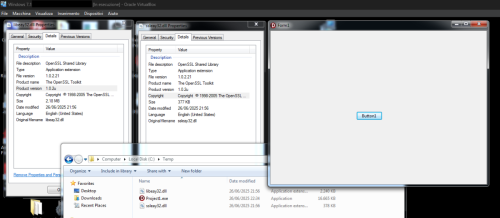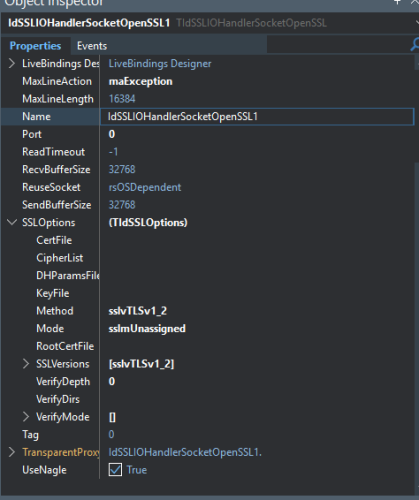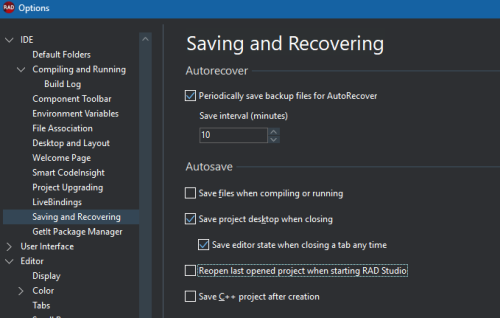

DelphiUdIT
-
Content Count
773 -
Joined
-
Last visited
-
Days Won
17
Posts posted by DelphiUdIT
-
-
7 hours ago, dmitrybv said:I tested RAD Studio 12.1 Community Edition.
For this edition, the "Detail" properties of the bds.exe contain the value “Personal”.
I don’t know what the value Personal means and whether it is related to the concept of Edition at all.SKU: Enterprise, Professional, Personal (this may be Community Edition).
Source: BDS.EXE and LicenseManager.exe
I cannot find the Architect SKU, it is possible that is derived from something else.
They (Embarcadero) spoke about this way to find a kind of product in Alexandria news note.
So, I think from that release we had the opportunity to use it.
-
4 minutes ago, dmitrybv said:dcc32.exe does not generate any error.
You can understand that something went wrong only at the end of the installation, when bpl packages are registered in the registry for IDE.
dcc32.exe does not create bpl packages and then it is already clear.
But I want to give the user information about the impossibility of installation before the installation process begins.
Why don't you use this:
10 hours ago, Kazantsev Alexey said:Look at https://docwiki.embarcadero.com/RADStudio/Alexandria/en/IDE_Command_Line_Switches_and_Options for bds.exe /ProductInfo:SKU
-
Wrong answer ...
-
Embarcadero generally maintains good compatibility on its products, but obviously when talking about a product that is at least 16 years old, it may be that some manual changes are made.
Then there is the third-party libraries to think about....Further info: for the COMMUNITY license, C++ and DELPHI cannot coexist.
-
8 hours ago, Remy Lebeau said:After the change, Indy no longer uses that. It now lets OpenSSL use whatever default cipher list it was compiled with.
Actually thare is something wrong with this (test on Intel platform, Win11 physical machine, Win 7.1 on VirtualBox VM):
1) Same DLL x64 (SSL 1.0.2u), Indy bundle (Rad 12.3), Win 11 works with the host indicated by @Del Murray with or without Chiperlist.
2) Same DLL x64 (SSL 1.0.2u) and exe, Indy bundle (Rad 12.3), Win 7.1 (VM) works with the host indicated by @Del Murray ONLY with explicity set of Chiperlist.
This can only be explained if by default the host (server) requested one or more "ciphers" not available in Windows 7 other than those in the ChiperList (because otherwise it could use one of those even if they are not explicit).
But running the test via SSLLabs you see that the server's preferential request (for TLSv1_2) corresponds to the indicated CipherList.
So there is something in the operating system that introduces an unmanaged variant (for example in Windows 7 Indy or SSL they use the CLIENT's Chiper preference by default while in Windows 11 the Server's preference is used). And if the client does not have a preference list, what does it propose?When I have a moment I will do some tests on this.
For me is not a problem because since I used TLS, I always insert ChiprList (in fact I have several applications that run with TLSv1_2 in Windows 7 in an industrial environment).
-
Uhmm, this is a topic about your error and they solve using the update version of Indy and Delphi (from Seattle to Berlin) : https://en.delphipraxis.net/topic/2950-indy-http-error1408f10bssl3_get_recordwrong-version-number/
I don't know if is the same trouble ...
EDIT, try this old thing: set the PassThrough of SSLIOHandler to false.
After setting the ChiperList inserto this line:
IdSSLIOHandlerSocketOpenSSL1.PassThrough := false; -
-
1 hour ago, Del Murray said:Do you see anything here about SSL3 ??? me either
I think the SSL3 is only an symbol to identify the security protocol SSL in general way, not really about SSL3 protocol.
But really I don't know way the client doesn't respond to TLS ... I try with a VM ,,, stay tuned ...
-
58 minutes ago, Del Murray said:It would be a different issue if my cipherlist for TLSV1.2 was not compatible with the API i'm trying to access but I cant get my webbroker app to accept a different set.
I cant change the default list in the sslopenheader , it cant be written to AFAIK so it might be interfeering. Guess guessing ... I know what the error is but dont know how to fix it.
After 45 years I'm geginning to hate this business.
Webbroker should use only the communication channel, doesn't mind what is the crypto protocol used and how is used, That is how the stack should works, So, if you set the SSLIOHandler correctly all should work.
-
I tried now (like I tried Tuesday) with the host that you gave us, and it works for me.
And I tried with and without set the Chiperlist: since the host use TLSv1_2 and TLSV1_3 and as the A+ evaluation you don't need to setup a ChiperList. Normally the connection between Client and Server use the chiper choose by server and setup a ChiperList in your client is for your security.
The ChiperList between server and client must match at least one element.
To try I simply put an TIdHTTP and an SSLIO Handler and setup only two properties on IDHTTP1 (HandleRedirects and IOHandler), and one on SSLIOHandler (Methods->sslvTLSv1_2 in SSLOptions):
Try to do a GET from HTTP like this:
If you don't have any errors, it is OK.
-
42 minutes ago, Del Murray said:Actually, I think the easiest question to answer is .... where can I find SSLEAY32.DLL and LIBEAY32.dll most current versions that work with Indy10 ?
Never mind. Got 'em .
This is the Indy binaries repo for SSL, the bundle version of Indy ('till now) works with 1.0.2.u : https://github.com/IndySockets/OpenSSL-Binaries
-
May be, the ChiperList list should be construct like this:
CipherList := '!EXPORT:!LOW:!aNULL:!eNULL:!RC4:!ADK:!3DES:!DES:!MD5:!PSK:!SRP:!CAMELLIA'+ ':ECDHE-RSA-AES128-GCM-SHA256'+ ':ECDHE-RSA-AES256-GCM-SHA384'+ ':ECDHE-RSA-CHACHA20-POLY1305'+ ':ECDHE-ARIA256-GCM-SHA384'+ ':ECDHE-ARIA128-GCM-SHA256'+ //Weak ma good with old prducts ':ECDHE-RSA-AES256-SHA384';And take care that scanning the site you indicate, there is a mandatory support to SNI. I don't think if Indy support SNI.
EDIT: with Indy Bundle (Delphi 12.3) and TLSv1_2 (OpenSSL ver. 1.0.2u) X64 is working the connection with that host.
-
34 minutes ago, dummzeuch said:And that was most likely the reason. The compiler only compiles units that have changed. Changing the include file does not change the units. To ensure that a unit is recompiled after a change to an include file, you must do a complete build of the project(s).
The same applies to defines set in the .dproj file btw. Changing them does not trigger a complete rebuild.
If you want to be really paranoid about this, delete all units from the unit output path. This ensures that every unit will be recompiled. I do that once in a while.
I'm aware of this, and this may be logical, but in the past I had to do 2 (TWO) times COMPLET REBUILD. It didn't work with just one. ... but not always, only sometimes.
I know that because I allocate manually the "console" depending of that symbol and without this the I/O error will be produced if some "writeln" is executed (confirmed also by debugging).
-
2 hours ago, dummzeuch said:Alternatively you can define it in an include file and include that file in all units that require the symbol. That latter approach is used by most libraries because a library cannot add anything to the project options.
In the past time (surely prior 12.x) I was used to do this, but I stopped 'cause many times the change of the "symbol" define seems that not apply to all units where the symbol was used. It was like if some untis were not compiled.
I used the "DEEP_DEBUG" symbol to do a "writeln" for debugging, but sometimes i delete it and the "writeln" was executed the same.
I had to compile almost two times the project to make a real change.
I have never looked into the problem in depth, because when you have it you are usually already busy up to your neck. So I changed the habit of using the definition in the project options.
And when I compile packages (i.e. libraries) ... I always recompile them TWICE.
I don't know if this anomaly exists in the current version, but I don't even want to try it.
-
Like you told, If you want to define global "symbols" you must insert them in the Project Options / Delphi Compiler / Conditional Defines:
50 minutes ago, Vandrovnik said:...but still would like to know why it is not possible to define it in .dpr.
You can define it in .DPR like in any other unit, but it is only valid inside that unit.
And there should be no errors. May be your line (I think is about a new unit in the uses clause) is inserted in a bad place (like if the previous line has already a ';' terminator) or should be terminated with a ',' ...
-
53 minutes ago, himitsu said:Thanks, I have to check if something is wrong ... even if apparently everything is working (but I don't use the reported units ... at least ...)
 .
.
P.S.: I had already changed the reference from "Win32Api" to "WinApi.Windows" in the WINMD units I use and deleted the Win32Api unit .... maybe that's why I never had problems.
The alternative
might be better ...
@himitsu, yes the word "oggi" means "today". That is the screenshoot from the QP in my language.
-
1 hour ago, pcoder said:Delphi winmd is not available to me (latest CE user), so I don't know,
but I recommend to compare it with other winmd Pascal providers.I already have this (old version), but it cannot be compared with the one provided by Embarcadero. They have totally different "constructs" and therefore the comparison is practically impossible.
EDIT: I mean massive comparison. you have to test every single function.
The Embarcadero one however reports help data such as the link to the Microsoft page for each single function and other info.
example (Emb.):
///<summary>Documentation: https://docs.microsoft.com/windows/win32/api/winnt/nf-winnt-rtlinterlockedflushslist</summary>
///<remarks>
///<para>Supported since: <i>windows5.1.2600</i></para>
///</remarks>
function RtlInterlockedFlushSList(var ListHead: SLIST_HEADER): PSLIST_ENTRY; stdcall;
{$EXTERNALSYM RtlInterlockedFlushSList}
example (Other);function RtlInterlockedFlushSList(var ListHead: SLIST_HEADER): PSLIST_ENTRY; stdcall; external 'ntdll.dll' name 'RtlInterlockedFlushSList'; {windows5.1.2600}
Thanks anyway for the update.
-
Hello, today this comment (the bottom in the figure) appears in the QP (I omitt the name of the annotator)
Someone, may be the same who post this, can clariry what means? I use WINMD and have never found any bugs since.
But I'm worried that there is something latent or hidden that I am unaware of.
Thanks.
-
In the past I also used Oracle SDK and had to set the JAVA_HOME environment variable which points to the java bin folder.
But if you want to install to bundle Java runtime (Adoptium) go to "Manage Features" from IDE and check the "Adoptium ..." box in the listed choices.
-
A curiosity: why you elevate (run as administrator) the IDE ? It's not needed, normally.
-
May be is a stupid information: and try with ATTACH instead to do a direct debugging ?
-
I don't know about log files from IDE.
Have you installed the latest May patch (you can find it on Getit)? You can also download it on MyDownloads of Embarcadero.
Uncheck the options "Tools/IDE/Saving and recovering/
"Reopen last open project ..."
so the IDE start without loading a project.
P.S.: If you have any third-party add-ons installed, try uninstalling them all and adding them one at a time to see which ones might be causing you problems.
-
 1
1
-
-
3 hours ago, Angus Robertson said:Google Trust Services offers an excellent alternate to Let's Encrypt and offers almost the same free certificates
3 hours ago, Angus Robertson said:Google needs the Google Cloud CLI Windows application installing
It looks like Google wants a paid account too. After that the certificate is going to be free...
I tried the Acme version with Let's Encrypt and with Buypass and all is working.
-
I have 1, 2 or 3 monitors in use (depens on working places, project type and debug features needed).
In the early versions I had those annoying problems but in the last version (12.3) I didn't found them.
I always use monitors with 100% scale settings and always IDE with HIGH-DPI-Aware (normal start).
My IDE is ALWAYS in the first monitor (the primary) and the applications run always in the secondary monitor if available. In the third monitor I put some units undocked or documents.
I use this IDE layout:
and as I already said in the new Rad Studio's release I never had those issues.
In High-DPI tests, I found some issues like those reported in other topics and in the ESP (Embarcadero service portal).
![Delphi-PRAXiS [en]](https://en.delphipraxis.net/uploads/monthly_2018_12/logo.png.be76d93fcd709295cb24de51900e5888.png)









Delphi 13 beta
in Delphi IDE and APIs
Posted
But you and Remy are still there with a greater, precious and fundamental tireless contribution.
Thank you for all, for what you have done and for what you will do (to others of TeamB too, that I don't know).